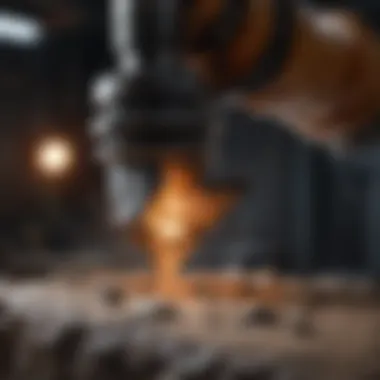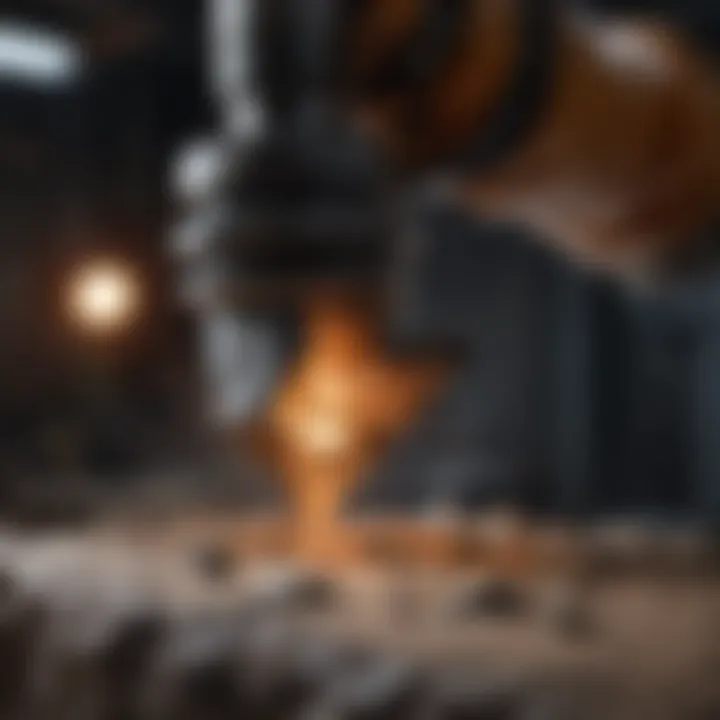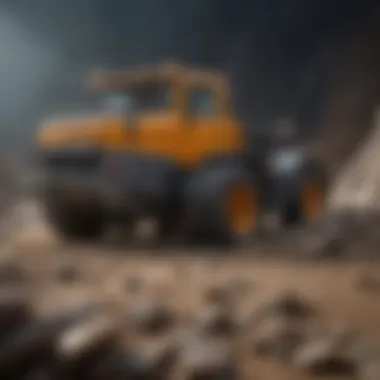Understanding Rock Cutters and Polishers: Tools and Techniques


Intro
Rock cutters and polishers serve as vital tools for geology enthusiasts and professionals alike. Their existence enriches the experience of collecting and shaping geological specimens into beautiful artifacts. This article aims to dissect the various types, applications, and operational techniques of these tools. Understanding these aspects is crucial, as it will guide enthusiasts toward achieving optimal results while prioritizing safety and efficiency.
The world of rock shaping is not merely about transforming rough stones into polished jewels; it encompasses a deep appreciation for geological history, art, and craftsmanship. Knowledge of rock cutters and polishers equips collectors and hobbyists with essential skills and insights necessary for enhancing their craft. By diving into the tools and techniques in detail, we hope to position the reader firmly in the position of informed practitioner.
In this exploration, we will also look at the history and evolution of these tools, examining how advancements in technology have redefined rock cutting and polishing. Furthermore, we’ll speculate on future innovations that could shape the industry, unearthing trends that collectors should watch closely.
Ultimately, this comprehensive guide serves to inform and elevate the practices of rock enthusiasts, educators, and collectors, establishing itself as a resilient resource within the broader domain of geological education and craftsmanship.
Prelude to Rock Cutters and Polishers
Rock cutters and polishers serve as essential tools for both amateur enthusiasts and seasoned professionals in the realm of geology and rock crafting. They facilitate the transformation of raw stones into aesthetically pleasing shapes, making them suitable for various applications. Understanding these tools is vital, as they not only enhance the visual appeal of rocks but also preserve their geological integrity.
Defining Rock Cutters and Polishers
Rock cutters are specifically designed machines or handheld tools used to slice raw rocks into manageable pieces while allowing for precision in shaping. These tools use a variety of blades and technologies, tailored for different types of rock and complexity of tasks. Polishers, on the other hand, are used to refine the surfaces of these cut rocks, providing a smooth finish that can enhance both texture and sheen. Together, these tools form the backbone of the rock shaping process, enabling collectors and artisans to achieve intricate designs.
The Importance of Rock Shaping
Rock shaping is not only a craft but an art form that carries scientific importance. The ability to cut and polish rocks affects the collection and study of geological specimens. For educators and students, properly shaped rocks can serve as effective teaching tools, illustrating concepts in geology and earth sciences. Furthermore, rock shaping plays a key role in jewelry making and artistic creations, where the quality of the finished product significantly impacts its value. Each cut and polish adds to the beauty and character of the stone, making it essential to utilize the right tools and techniques for optimal results.
"The beauty of a polished stone reflects the care taken in its shaping process."
In summary, understanding rock cutters and polishers opens up a world of possibilities for transforming ordinary stones into remarkable creations. By mastering these tools, one can appreciate not only the aesthetic outcomes but also the underlying geological narratives that each rock has to tell.
Types of Rock Cutters
Understanding the types of rock cutters is essential for anyone involved in rock shaping. Different cutters serve unique purposes and vary in effectiveness based on the specific type of rock being worked on. Knowing about various types allows users to select the appropriate tool for their needs. Understanding these tools can lead to better results and safer practices in both professional and hobbyist environments.
Diamond Blades
Diamond blades are among the most commonly used tools for cutting rock. They are designed with diamond grit embedded in the cutting edge. This structure allows them to slice through hard materials with precision and efficiency. The main advantage of diamond blades is their durability. They can cut through various types of stones, including granite and marble, without degrading quickly.
Additionally, using diamond blades can lead to smoother cuts, minimizing the need for further polishing. It is important to select the right size and type of diamond blade based on the material and desired outcome.
Wire Saws
Wire saws utilize a thin, flexible wire with diamond particles to cut through rock. Unlike traditional saws, the wire can maneuver around complex shapes and provide a high level of accuracy. This tool excels in areas where precision is key and is generally favored for delicate work. One significant benefit of wire saws is their ability to cut large volumes of material with minimal waste.
Using a wire saw involves careful handling. The tension on the wire must be controlled to avoid breakage. Therefore, operators need to be mindful of their technique to ensure successful cuts.
Sawing Machines
Sawing machines encompass a range of devices that provide cutting functions with greater power and speed. These machines can be equipped with various blade types, including diamond and metal blades, suited for different rock materials. The advantage of sawing machines is their ability to handle larger projects and more significant quantities of material.
While they can be an asset for commercial operations, users must consider their set-up and maintenance requirements. Training to operate these machines safely is crucial. A well-maintained sawing machine not only increases efficiency but also enhances the safety of the work environment.
Types of Rock Polishers
Rock polishers are vital tools that can significantly enhance the aesthetics and quality of rocks and gems. Understanding the distinctive characteristics and functions of various types of polishers can help enthusiasts choose the most suitable tool for their projects. This section discusses the three primary types of rock polishers: vibratory polishers, barrel polishers, and flat lap polishers. Each type has unique elements, benefits, and considerations, making it essential to comprehend their specific roles in the polishing process.
Vibratory Polishers
Vibratory polishers are designed to create a smooth and shiny finish on rocks through a vibrating mechanism. These tools work by agitating the materials inside the polishing chamber, enabling the abrasive media to efficiently contact and polish the rocks.
- Benefits: Vibratory polishers are known for their efficiency in processing multiple rocks simultaneously. This feature is especially beneficial for hobbyists who work on several stones at once, saving both time and effort. Additionally, the gentle tumbling action reduces the risk of chipping or damaging the rocks during the polishing process.
- Considerations: When using vibratory polishers, it is important to select the correct abrasive media, as this will affect the final finish. Common media choices include ceramic, plastic, and natural stones. The choice depends on the hardness of the rocks being polished and the desired outcome.


Barrel Polishers
Barrel polishers, also known as rotary rock tumblers, are cylindrical machines designed to polish rocks by rotating them in a barrel filled with abrasive materials. This method allows for a more extensive polishing action, making it suitable for achieving a glossy finish on various types of stones.
- Benefits: One of the standout features of barrel polishers is their ability to handle rough stones and transform them into polished gemstones. They are particularly effective for those who wish to achieve a high-gloss finish, as the continuous tumbling action mimics natural erosion processes.
- Considerations: Barrel polishers usually require a longer processing time than vibratory machines. Users should be patient and attentive to the polishing phases, ensuring proper grit progression from coarse to fine abrasives. Overloading the barrel can lead to unsatisfactory results, so it’s essential to follow the manufacturer's guidelines regarding load capacity.
Flat Lap Polishers
Flat lap polishers are professional-grade machines that provide a flat surface for polishing cabochons and other rock shapes. These tools mainly use fixed diamond discs that rotate at high speeds to achieve desired polish results on flat surfaces.
- Benefits: The precision and control offered by flat lap polishers are unmatched. They allow users to work on specific areas of a stone, facilitating detailed polishing and refining edges. The versatility of flat lap machines makes them suitable for jewelers and serious collectors who require high-quality finishes.
- Considerations: Operating a flat lap polisher can be more complex than using other types of polishers. Those using this equipment should be familiar with different grit sizes and their respective applications. Additionally, proper maintenance and cooling of the discs are essential to preserve their effectiveness.
In summary, the choice of rock polisher fundamentally depends on the user's objectives, the type of rocks being processed, and the desired finish. Careful consideration of these factors can lead to more rewarding results in rock polishing.
Applications of Rock Cutters and Polishers
Understanding the applications of rock cutters and polishers is vital for anyone interested in rock and mineral preparation. These tools serve multiple purposes that extend beyond mere aesthetics; they enable creative expression, practicality, and educational opportunities.
Artistic Creation
Artistic endeavors involving rock art are gaining traction among creators and enthusiasts. Rock cutters help artists shape raw materials into stunning pieces. For instance, sculptures and decorative items can be crafted using tools such as diamond saws and vibratory polishers. With these, artisans can manipulate stones with precision to achieve intricate designs. Furthermore, the societal appreciation for handmade items fosters a marketplace for artists who utilize these techniques. Engaging in this craft not only yields financial return but also fulfills an intrinsic desire for creativity.
Processing rocks enhances their visual appeal. Artists can exploit the unique textures and colors of different rocks, translating their innate beauty into tangible forms. The combination of cutting and polishing allows for varied finishes, from rough to highly polished surfaces. This versatility enables an array of artistic expressions, meeting the diverse preferences of audiences.
Jewelry Making
The jewelry-making industry represents a significant application of rock cutting and polishing. Gemstones, commonly utilized in jewelry pieces, undergo meticulous shaping and polishing. Tools such as barrel polishers provide the smooth finish that customers often seek in high-quality jewelry. A well-polished gemstone tends to reflect light more effectively, enhancing its allure and market value.
Moreover, the customization potential in jewelry-making, through the use of rock cutters, allows artisans to create unique designs tailored to individual customers. Each piece can be designed to accentuate the natural characteristics of the material being used, providing a personal touch that mass-produced items lack. This aspect not only appeals to buyers but also empowers artisans to showcase their skill and creativity.
Educational Demonstrations
Educational institutions increasingly depend on rock cutters and polishers for geological studies. These tools foster hands-on learning experiences for students. Demonstrations using cutters reveal how rocks are formed, modified, and refined for various applications. This practical aspect enhances theoretical knowledge, allowing students to grasp complex geological concepts more effectively.
Educational demonstrations also serve as a medium to discuss environmental impacts. Audience engagement increases when learners can physically see the processes involved in rock shaping. Instructors can address questions related to tool safety, material choice, and the importance of sustainability within their field. Educational settings can incorporate these topics into curricula, offering students insights not only about geology but also about responsible practices in the industry.
"Hands-on experience with rock cutters not only educates but also inspires future generations of geologists and artisans."
In summary, the applications of rock cutters and polishers are diverse and significant. They enhance artistic expression, facilitate the jewelry industry, and serve educational purposes. As users become more adept in utilizing these tools, they unlock new potentials within their respective fields.
Choosing the Right Tool
Selecting the appropriate rock cutter or polisher is fundamental to the success of any project involving rock shaping. Making a wise choice enhances the final results and ensures the safety of the user. Various factors must be taken into account when determining the right tool, each influencing the efficiency and quality of the work.
Factors to Consider
When considering which tool to utilize, it is crucial to evaluate several key elements:
- Type of Rock: Different rocks have varying hardness and aesthetics. Some tools are better suited for softer materials like limestone, while others excel with harder stones like granite.
- Project Scope: The nature and scale of the project will dictate the tools required. Large sculptures may necessitate heavy-duty saws and polishers, while smaller items may require hand-held devices.
- Precision Needs: For detailed work, such as jewelry making, precision is essential. Tools that allow for meticulous shaping and finishing should be prioritized.
- Budget Considerations: Quality tools may involve a significant investment. Careful thought should be given to budget while ensuring that the selected tools meet project needs.
- Ease of Use: Depending on the user's familiarity with the tools, some options may be easier to handle than others. This factor can significantly affect the decision.
"Choosing the right tool is about understanding the interplay of your material and your project goals."
User Skill Level
The skill level of the user plays a vital role in the decision-making process. Those who are new to rock cutting may benefit from tools that are easier to operate and have built-in safeguards. Here are some considerations based on skill level:
- Beginners: Entry-level users should consider equipment that is less intimidating and perhaps has more guidance available, such as barrel polishers or small vibratory tools.
- Intermediate Users: For those with some experience, a broader range of tools can be utilized. Options such as diamond blade cutters may be more appropriate here, as users will better understand their functions and limitations.
- Advanced Users: Experienced users can handle complex machinery, such as wire saws, which require a good understanding of operational techniques. Their skill allows them to push the boundaries of creativity.
Ultimately, the decision about what tool to choose must take all these factors into account. The right selection can streamline the process and vastly improve the outcome of rock cutting and polishing efforts.


Operational Techniques
Operational techniques form the foundation of effective rock cutting and polishing. These methods are not merely practical steps; they enhance the final quality of the work. A systematic approach can significantly affect the overall outcome, ensuring that desired shapes, finishes, and structural integrity are achieved in the rocks being worked on. The importance of mastering these techniques cannot be overstated, as they promote both efficiency and safety in the workspace.
Setting Up Your Workspace
Creating an optimal workspace is the first step toward successful operation. A well-organized environment reduces errors and improves productivity. Key elements to consider include:
- Surface Stability: Use a sturdy table specifically designated for rock work to minimize vibrations and movements.
- Lighting: Ample lighting is essential for precise operations, particularly when inspecting your work closely.
- Tool Arrangement: Keep all tools within reach. This can minimize unnecessary movement, allowing for better focus.
- Ventilation: Ensure that the area is properly ventilated, especially when using machines that generate dust.
A clear workspace also needs to be clean and free from distractions. This focused environment can lead to better results in shaping and polishing your rocks.
Safety Precautions
Maintaining safety in the workspace is crucial. Working with rock cutters and polishers involves inherent risks, including cuts, inhalation of dust, and noise. Therefore, specific precautions must be adhered to:
- Personal Protective Equipment (PPE): Always wear safety goggles to protect your eyes from debris, gloves to shield your hands from sharp edges, and masks to prevent dust inhalation.
- Equipment Inspection: Regularly check tools for functionality. Faulty equipment can lead to accidents and poor results.
- Emergency Procedures: Be aware of emergency shut-off procedures and keep a first aid kit handy.
- Avoid Distractions: Focus on the task during operation. Avoid casual conversation or distractions that can lead to accidents.
Safety should never be an afterthought; it must be integrated into every step of your operation.
By prioritizing safety, not only do you protect yourself but also ensure a seamless workflow.
Step-by-Step Operation
The step-by-step operation involves a sequence of actions that guide you through cutting and polishing rocks effectively. Here’s a simplified workflow:
- Selecting the Right Tool: Match the tool to the rock type and desired outcome. For hard stones, diamond blades work best, while softer stones may suit wire saws.
- Preparation: Secure the rock firmly and adjust your tools for the initial cuts. Take measurements where necessary to achieve desired dimensions.
- Cutting: Operate the cutter slowly at first to maintain control. Gradually apply more pressure as familiarity with the tool increases.
- Polishing: After cutting, switch to the polisher. Keep the rock moving to ensure an even finish. Persist with gentle pressure to maximize the polish without damaging the stone.
- Finishing Touches: Inspect the finished product. Any imperfections can be addressed with additional polishing or finer grits.
This structured method ensures that you not only achieve the desired results but also enhance your skills over time. By adhering to operational techniques, you cultivate a routine that promotes superior craftsmanship.
Common Mistakes and How to Avoid Them
In the realm of shaping and polishing rocks, recognizing the common mistakes that can impede progress is vital. These errors can range from technical oversights to neglect of tool maintenance. By understanding these pitfalls, rock enthusiasts can enhance their skills, produce superior finishes, and ultimately enjoy their craft more fully. This section addresses two primary areas of concern: overworking material and ignoring tool upkeep. Each aspect is crucial for anyone engaging in rock cutting and polishing.
Overworking the Material
Overworking material is a frequent issue faced by both novice and experienced practitioners. When cutting or polishing rocks, it is essential to recognize when sufficient progress has been achieved. Spending too much time on one area can lead to
- uneven surfaces,
- unnecessary wear,
- or even irreversible damage.
First, it is important to listen to the material itself. Each type of rock has its characteristics, and understanding these will help inform the appropriate techniques and duration of work needed. For example, softer stones can be worked more quickly than harder ones, which require greater patience.
To avoid overworking, set time limits and take breaks. Step back frequently to assess progress. This strategy allows for a more objective view of the work, preventing excessive back-and-forth that leads to diminishing returns. Utilizing a systematic approach can also help. Break the task into smaller, manageable segments, focusing on one area before moving to the next. Awareness and discipline in execution will improve the work's overall quality.
Ignoring Tool Maintenance
Tool maintenance is an often overlooked but critical component in the longevity and performance of rock cutting and polishing equipment. Each tool requires specific care to function optimally, and neglect may result in poor results or even damage. Dull blades or compromised polishing pads can lead to substandard finishes, which is not ideal for any rock enthusiast.
Regular cleaning is essential after each work session. Remove dust, debris, and residue from tools. This practice not only enhances performance but also extends the life of the equipment. Inspect tools for signs of wear, such as cracks or dull edges, and address any issues promptly.
In addition, following manufacturer's recommendations for maintenance is wise. Each type of tool may have unique requirements, whether it is lubrication or alignment. Ignoring these guidelines can lead to complications that could have been easily avoided. Incorporating a routine maintenance schedule can foster good habits and prolong the efficacy of the tools.
"Regular care of your tools ensures better outcomes and saves money in the long run. The quality of your work depends on the quality of your equipment."
By avoiding these common mistakes—overworking the material and ignoring tool maintenance—rock collectors and enthusiasts can significantly improve their results. With attention to practice and tool care, the path to achieving expertly cut and polished stones becomes clearer.
Caring for Your Tools
Caring for your tools is an essential practice for any rock cutter or polisher enthusiast. Proper maintenance not only prolongs the life of tools but also ensures optimal performance during use. Neglecting care can lead to decreased efficiency, poor results, and even accidents. This section outlines key practices in maintaining rock cutters and polishers, emphasizing the importance of cleanliness and proper storage.


Cleaning Procedures
Cleaning your tools is a fundamental step that cannot be overlooked. After each use, it's vital to remove dust, debris, or any residue that may accumulate on the surface of your equipment. For rock cutters, this can include particles of stone or polishing compounds that may harden over time if not cleaned away.
Here are some steps to follow for effective cleaning:
- Use a soft brush: A soft-bristled brush can help dislodge dust and debris from crevices without damaging the tool.
- Wipe with a damp cloth: Use a damp cloth to wipe down surfaces after brushing. Avoid soaking or applying too much water, especially on electronic parts.
- Check for rust: Regularly inspect metal parts for signs of rust and treat them immediately with appropriate rust remover to prevent further damage.
- Lubricate moving parts: After cleaning, apply a light lubricant to any moving parts to ensure smooth operation.
Regular cleaning prevents build-up and helps in maintaining the precision needed in rock cutting and polishing. This, in turn, keeps tools functioning at their best, which is critical for achieving the desired finish on your rocks.
Storage Recommendations
Proper storage of your tools is just as important as regular cleaning. How you store your rock cutters and polishers can significantly affect their longevity and usability. Here are some best practices for storing your tools:
- Use toolboxes: Store smaller tools in a closed toolbox to protect them from dust and moisture. This will help maintain their condition and minimize wear.
- Hang larger tools: If you have larger equipment, consider hanging them on a wall with hooks. This keeps them off the ground and allows for easy access while preventing accidental drops or damages.
- Maintain a stable environment: Store your tools in a stable environment with controlled temperature and humidity. This can prevent rust and degradation of materials over time.
- Avoid overcrowding: Ensure there is enough space in your storage area to allow for easy access and to prevent tools from knocking against each other.
By implementing these storage tactics, you enhance your tools’ durability and reliability, ensuring they remain in prime condition for the next project.
"Well-cared tools not only perform better but also save you time and effort in your rock crafting endeavors."
Focusing on cleaning and proper storage establishes a strong foundation for any practitioner aiming to achieve excellence in rock cutting and polishing.
The Evolution of Rock Cutting and Polishing Technology
The evolution of rock cutting and polishing technology is a significant aspect of the field, influencing not just the tools used but also the methods and outcomes in various applications. Over the years, advancements have not only improved efficiency but have also enabled a higher level of detail and precision. This evolution can be seen through various phases—from primitive tools to sophisticated machinery, reflecting changes in both materials and techniques. Understanding these changes helps enthusiasts and professionals appreciate the tools they use and the potential they hold.
Historical Overview
Rock cutting and polishing have ancient roots, with evidence of early stone tools dating back thousands of years. These early methods involved basic implements made from harder materials, such as flint, to shape softer stones or minerals. As civilization progressed, the tools evolved to include metal blades, which offered more durability and cutting ability.
The introduction of diamond tooling in the mid-20th century marked a significant turning point. Diamonds, being the hardest known material, allowed for cleaner cuts and longer-lasting tools. This meant that artisans could work with more diverse materials, including tougher rocks like granite and quartz. Moreover, means of powering tools transitioned from manual efforts to electric and hydraulic systems, vastly increasing productivity.
Modern Advances
In contemporary times, rock cutters and polishers have seen significant technological innovations. Among these, the development of CNC machines has revolutionized the industry. CNC, or Computer Numerical Control, allows for automatic shaping and polishing of rocks with previously unattainable precision. Users can input exact specifications, ensuring consistent outcomes, thus enhancing productivity.
Additionally, advancements in abrasive technologies have yielded superior materials. For instance, resin bond diamond pads and high-speed grinders enhance cutting efficiency and finish quality. Environmental considerations are also shaping advances; many modern machines are designed to reduce waste and incorporate more sustainable practices.
Future Trends
Looking ahead, the future of rock cutting and polishing technology seems poised for further transformation. One promising trend is the integration of artificial intelligence and machine learning in cutting processes. Such technologies might help operators analyze performance data to optimize their systems in real-time, improving not only cutting speed but also accuracy.
Another trend is the increasing use of multi-functional tools. This will allow collectors and artisans to shift from multiple machines to more compact, versatile options. Furthermore, 3D printing technology may some day enter this field, enabling the creation of custom shapes that were not possible with traditional methods.
The evolution of rock cutting and polishing is not merely about tools; it is about redefining what is achievable in craftsmanship.
Epilogue
In this article, we examined the essential role of rock cutters and polishers in various fields, such as geology and art. Understanding these tools is beneficial for both enthusiasts and professionals. Rock shaping and polishing can significantly enrich the experience of creating and collecting. The ability to manipulate materials transforms ordinary stones into polished works of art.
The relevance of this topic goes beyond just technique. It touches on the appreciation of nature's beauty and craftsmanship. Each tool discussed, from diamond blades to vibratory polishers, plays a vital role in achieving desired results. Selecting the right tool enhances the efficiency and quality of the work. Safety and proper maintenance cannot be stressed enough; they ensure long-lasting tools and safe operation.
"In the world of rock polishing, the right technique can be the difference between a dull surface and a stunning finish."
This understanding allows collectors and educators to harness the full potential of these tools, making learning and creation more rewarding.
Final Thoughts
As we conclude our exploration of rock cutters and polishers, it is clear that proficiency with these tools leads to greater satisfaction in rock crafting. Each step, from choosing the right equipment to maintaining it, contributes to success. The knowledge gained through this article is only the beginning of a rewarding journey. Every hobbyist can find their unique path in this creative endeavor.
Encouragement for Further Exploration
For those interested in delving deeper into rock cutting and polishing, consider joining online forums like Reddit or engaging with local rock clubs. Resources such as Wikipedia and Britannica offer valuable insights into techniques and innovations. There is always something new to learn. The community is vast, and sharing experiences can enhance skills further.
Pursue additional training or workshops. These opportunities build confidence and knowledge. Engaging with experienced users can lead to new perspectives and techniques. It is a field where improvement is continuous, and collaboration can yield exciting outcomes.



